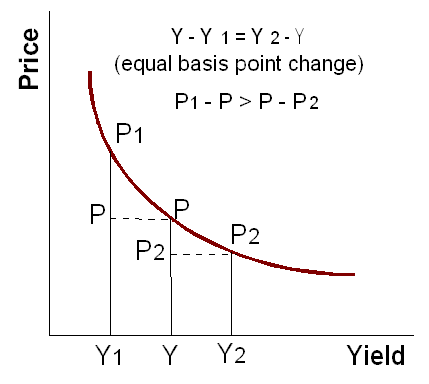Price Volatility CFA Level 1
Post on: 3 Июль, 2015 No Comment

Fixed Income Investments — Price Volatility
Price Volatility for Option-free Bonds
The fundamental change in price is that which causes yields to increase as price decreases and vice versa. This relationship is not linear, however, it is convex.
There are four properties concerning the price volatility of an option free bond:
1. Price moves in the opposite direction of a change in yields, but the percentage change is not the same for all bonds.
2. For small changes in yields, the percentage change is roughly the same no matter what direction rates move.
3. For large changes in yields, the percentage price change is not the same for an increase in yield as it is for a decrease in yield
4. For a given large change in yield, the percentage price increase is greater than the percentage price decrease.
Although the above properties apply to percentage change they still apply to dollar changes.
Properties three and four involve the convex shape of the price yield relationship. Property four states that with a long a bond, the price increase when rates decline will be greater than the price decrease when rates rise.
Positive Convexity
Positive convexity is what market participants refer to the yield/price relationship of option free bonds.
Price-Volatility Characteristics of Callable and Prepayable Securities
The price of a callable bond will react in the same way as an option-free bond when market rates are high. This is because there is less of a chance of the bonds being called by the issuer because they probably will not be able to refinance the bonds at a lower interest rate. When rates decline, on the other hand, the price increase of a callable bond will be held to that call price because of the increased chance of the bonds being called by the issuer. Meanwhile, option-free bonds will continue to see an increase in price as rates fall. Would you pay $105, for example, for a bond that could be called at $101 as rates drop? In essence, you give $4 dollars away. It is for this same reason that bonds are unlikely to be called by issuer when the rates are low.
These bonds contain negative convexity. That is, the price appreciation is less than its price decline when rates change by a large amount. The bonds will not always exhibit negative convexity; at higher rates they will exhibit positive convexity just like an option-free bond.
Price Volatility Characteristics of Putable Bonds
A bondholder can redeem puttable bonds on certain dates and at certain prices. The advantage of these bonds to an investor is that if market yields rise and the value of the bond falls below the put price, the investor can exercise the put option and stem his losses to the put price. This can not be done with an option-free bond.
Value of puttable bond = value of option free bond + the option.














